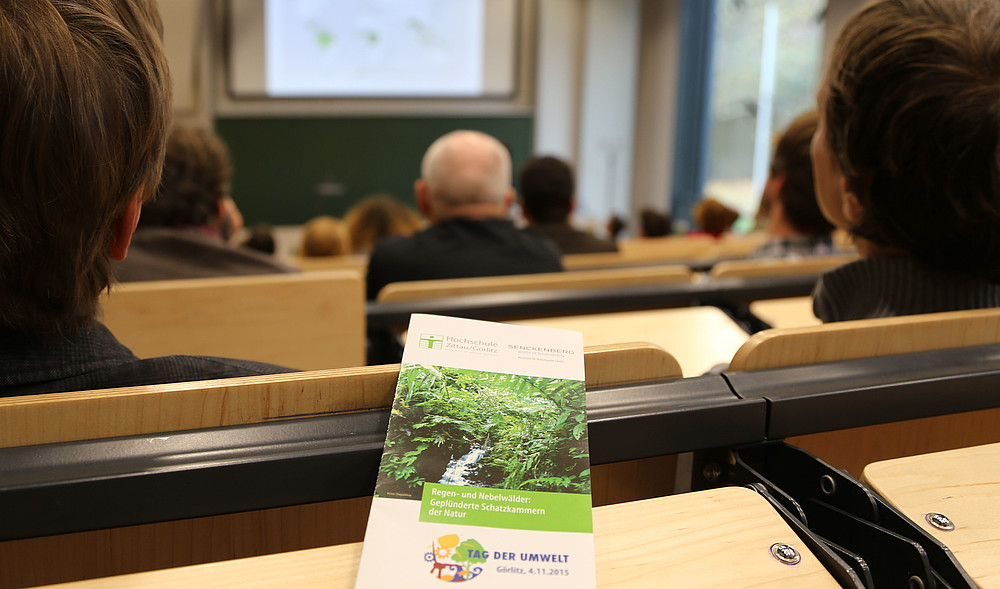"Rainforests and cloud forests: Plundered treasure troves of nature", a moving topic that filled the lecture hall at the Görlitz site of Zittau/Görlitz University of Applied Sciences. Prof. Dr. Christa M. Heidger, Vice President Education and International Affairs, together with Prof. Dr. Matthias Schmidt, Vice Dean of the Faculty of Social Sciences, welcomed a good mix of students, lecturers, university staff and employees of the Senckenberg Museum für Naturkunde Görlitz as well as interested members of the public.

The Vice President then introduced the audience to the topic with an introductory lecture. "Cloud forests are mountain rainforests that lie in the montane region of the tropics above the belt of predominant cloud formation," she said, differentiating the forests that gave the event its title. She illustrated the danger to the invaluable biodiversity of the rainforests. Tropical timber, palm oil, cattle breeding, the patenting of plant substances and urbanization are sought-after uses that pose a considerable threat to the existence of forests and the habitats of countless animal species. She ended her presentation with an explicit reference to the consequences of destruction, such as the loss of potential remedies, the loss of scenic beauty and the loss of cultural diversity of indigenous peoples, as well as effects on the local and global climate.
The following presentation by M.Sc. Dipl Ing. (FH) Denis Kupsch, researcher at the Georg-August-University Göttingen, followed on from the introduction and dealt in more detail with the topic "Influence of palm oil cultivation on biodiversity". After a brief introduction to the basics of palm oil, he used a case study entitled "A new palm oil plantation in the SW of Cameroon?" to present the content of his research project. He is currently working on agro-industrial development in tropical Africa, which, in the context of global palm oil producers, is exerting great pressure on forest landscapes. Integrated into these landscapes are traditional agroforestry systems, which are characterized by social and ecological complexity, but have so far been poorly understood. The project aims to provide basic information on the influence of different forms of land use on biodiversity, their social and economic significance and the possibilities for preserving existing ecosystems. Mr. Kupsch concluded his engaging and ambitious presentation with mitigation approaches, citing overarching topics such as certification and carbon payment systems, but also ways in which everyone can take personal action in their private use. For example, checking the ingredients and therefore avoiding products containing palm oil or using products from sustainable production.

The planned lecture by Dr. Rafael Ernst, curator and head of the herpetology section at the Senckenberg Natural History Collections in Dresden, unfortunately had to be canceled at short notice. He was excellently replaced by Dr. Matthias Nuss, Head of the Lepidoptera Section at the Senckenberg Natural History Collections Dresden. Dr. Nuss spoke on the topic of "Tropical forest remnants in northern Angola - condition, scientific research, protection options". It became clear that even the smallest remaining fragments of forest are home to an astonishingly high diversity of species. Here, the rainforest is not threatened by global corporations but by the local population, who cut down old trees with valuable wood for sale or hunt so-called "bush meat" for their food.

Prof. Dr. Annette Drews, from the Faculty of Social Sciences at Zittau/Görlitz University of Applied Sciences, completed the first lecture round. With her lecture "Experience Rio Negro - Gentle Tourism in the Amazon Basin", she made an easy transition from the scientific lectures of the previous speakers to a lively journey through the Amazon. With a presentation of numerous private photographs, she took the audience from Manaus into the jungle, where she lived together with indigenous people. These indigenous peoples were accompanied by the social scientist for many years and are still the destination of research trips with her students today.

The last lecture had the exciting title "The mountain that moved and the river that disappeared - environmental protection in the Colombian Andes". Here, the NGO Dapa Viva was presented by Colombian Ana Ocampo. She was supported in the translation by Armin Hirche. Mr. Hirche is a student at the Zittau/Görlitz University of Applied Sciences studying Ecology and Environmental Protection and spent his internship semester at Dapa Viva in Colombia. The NGO is involved in environmental education, nature conservation and research. In Colombia, a large part of the natural landscape has already been dangerously altered by the expansion of agriculture and the associated deforestation. This poses a serious threat to the fragile ecosystem of the little-studied cloud forests. The organization Dapa Viva is therefore carrying out research projects to expand knowledge about the interrelationships and is trying to raise awareness among the population about the vulnerability of nature.

Due to the time that had passed, the subsequent discussion was shorter than originally planned. It was moderated by Dr. Christian Düker, Press and Public Relations Officer at the Senckenberg Museum für Naturkunde Görlitz. He posed specific questions to the speakers and led the discussions.

The evening ended on a relaxed note with a free salsa workshop in the university auditorium, where drinks were sold for the benefit of Dapa Viva.




Contact:
Vice President Education and International Affairs
Prof. Dr. rer. nat. Christa Maria Heidger
Phone: 03583 612-3012
Mail: prorektorin-bildung@hszg.de

